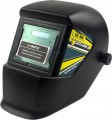Light filtering levels
The degree of light penetration provided by the mask filter, in other words, the degree of darkening (light attenuation) provided by the product.
The degree of dimming is indicated in DIN units, the larger its value, the lower the light transmission (that is, the darker the filter). Note that for chameleon masks (see "Type"), this paragraph indicates the characteristics of the light filter in the off state — that is, when it is not darkened and as transparent as possible. So for such products, the degree of light penetration is more of a reference value, and it is necessary to evaluate the actual degree of protection in "chameleons" by the minimum and maximum degree of dimming (see below).
In turn, for masks and glasses with permanent filters, the degree of light penetration is the main performance characteristic. Here you need to proceed from the following: a darker filter, on the one hand, provides higher protection against bright light, on the other hand, worsens visibility. So the optimal values for most welding work are 10 – 12 DIN, it is in this range that the characteristics of most modern masks / goggles without the "chameleon" function lie. More detailed recommendations on the optimal transparency of light filters for different situations can be found in special sources.
Turn-on time
The turn-on time of the filter in the chameleon mask (see "Type"), in other words, the time between striking the arc and darkening the filter to the operating level.
From a safety point of view, the turn-on time should be as short as possible: the faster the "chameleon" works, the less bright light from the arc enters the welder's eyes. On the other hand, reducing the reaction time affects the cost of the product. So for relatively small volumes of work, it is quite acceptable to use relatively “slow” masks — for
100 μs or more(especially since even in the simplest models, the reaction time does not exceed 1200 μs, while theoretically the maximum allowable value is 2000 μs). But for more serious use, you should pay attention to more "fast" options; nowadays, you can find masks with response times
from 75 to 100 µs,
from 50 to 75 µs, and even
less than 50 µs.
Filter class
Class is a complex indicator that determines the overall quality of the light filter in a chameleon mask (see "Type"). The class is indicated by 4 numbers, each of which describes a specific optical parameter. So, the first number indicates the overall clarity and lack of distortion; the second is the degree of light scattering; third — uniformity of blackout (presence/absence of visible blackout spots); the fourth is the angular dependence (how much the filter brightens when the angle of view deviates from the perpendicular). In each case, the larger the number, the worse this parameter is. The perfect indicator is considered to be 1/1/1/1, but in fact it is very difficult to achieve an perfect angular dependence, and there is no need to. Therefore, an indicator of 1/1/1/2 is considered quite sufficient even for a high-end professional filter.
Operating temperature
The range of ambient air temperatures at which the mask is guaranteed to be able to function normally. This parameter is especially important for "chameleons" (see "Functions"), because. the performance of the automatic filter directly depends on external conditions (in particular, at low temperatures, the response time may increase).

